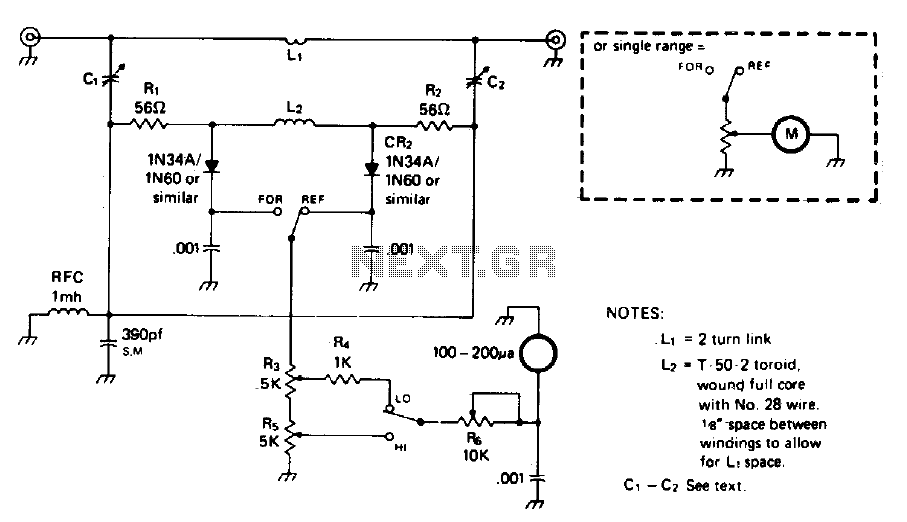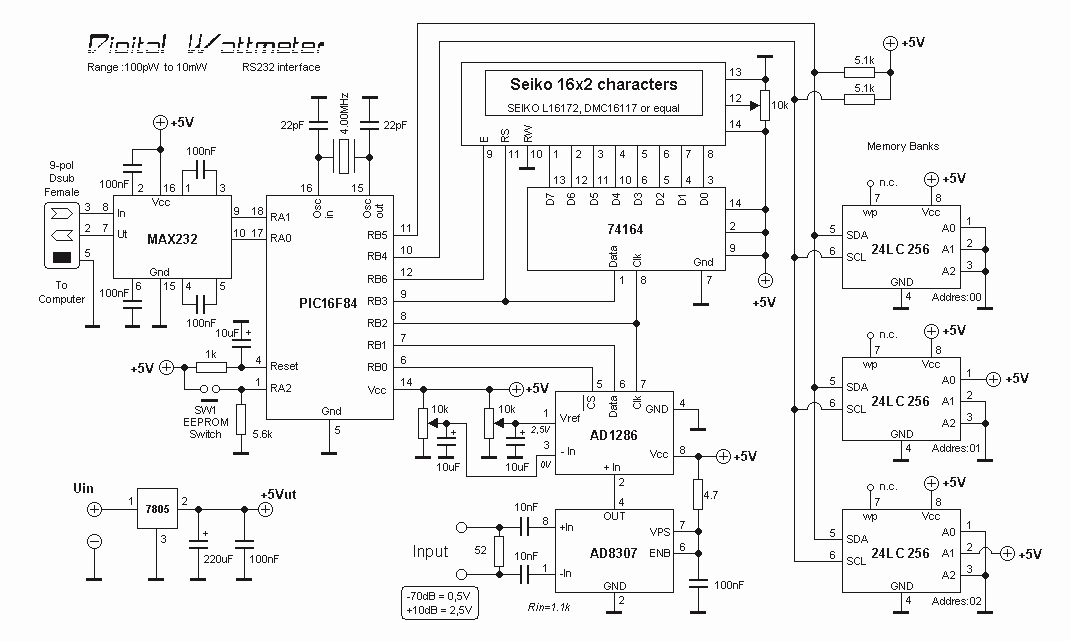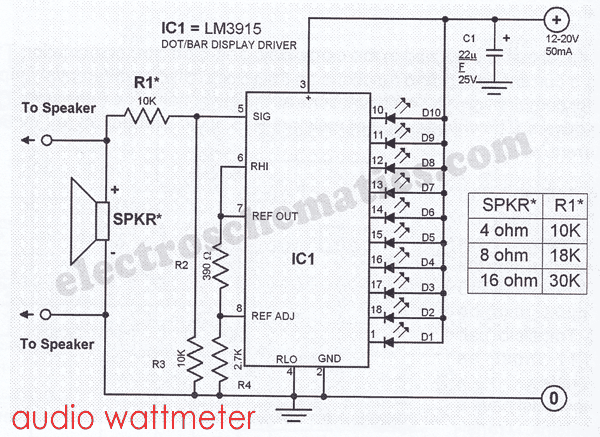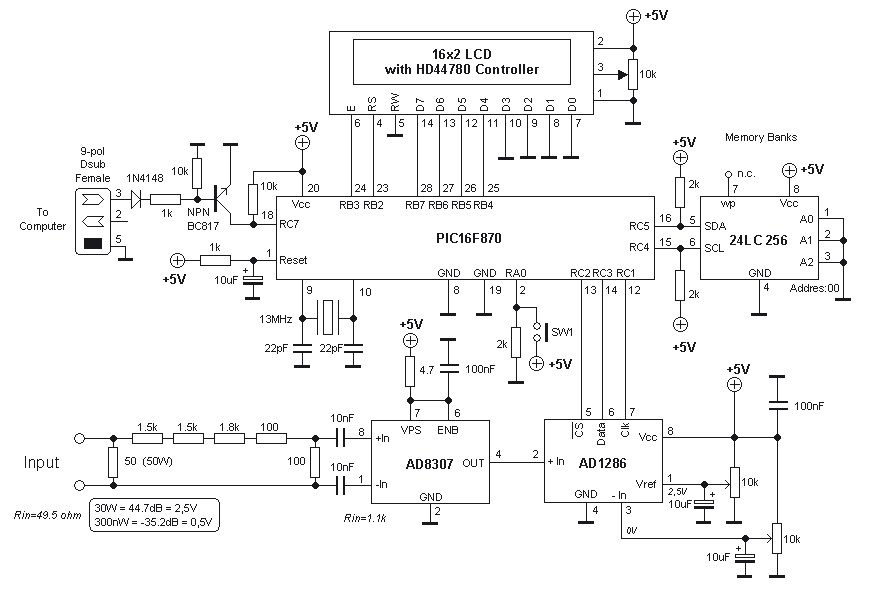
In-line wattmeter

The circuit is not frequency sensitive. Its calibration will be accurate over a wide frequency spectrum, such as the entire amateur HF spectrum, if the values of L2, the voltage divider capacitors C1, C2, and C3, and the resistances of R1 and R2 are chosen properly. R1 and CR1 should be matched for best results. Generally, R1 must be small compared to the reactance of L2 to avoid any significant effect on the L2 current, which is induced by the transmission line current flowing through L1. The lower frequency limit of the bridge is determined by the R1-R2/Ls ratio, and the cutoff occurs at the point where the value of R1-R2 becomes significant in relation to the reactance of L2 at that frequency.
The circuit described functions as a frequency-independent bridge, suitable for applications across the amateur HF spectrum. The design relies on careful selection of component values, particularly the inductor L2, the voltage divider capacitors C1, C2, and C3, as well as the resistors R1 and R2. It is crucial that R1 and CR1 are matched to optimize performance and ensure accurate calibration across the specified frequency range.
In this configuration, R1 should be significantly smaller than the reactance of L2. This condition is essential to prevent any adverse impact on the current flowing through L2, which is influenced by the transmission line current in L1. The interaction of these currents is critical for maintaining the integrity of the circuit's operation.
The lower frequency limit of the bridge is governed by the ratio of R1 and R2 to the inductance Ls. As the frequency decreases, the reactance of L2 will increase, and there will be a point where the combined resistance of R1 and R2 becomes comparable to the reactance of L2. This point marks the cutoff frequency, beyond which the circuit may no longer maintain its intended operational characteristics.
To achieve optimal performance, it is advisable to simulate the circuit using electronic design automation (EDA) tools to verify the component values and their effects on circuit behavior across the desired frequency range. This simulation can help identify any potential issues related to component tolerances and interactions, ensuring that the circuit remains functional and accurate throughout its operational spectrum.The circuit is not frequency sensitive. Its calibration will be accurate over a wide frequency spectrum, such as the entire amateur hf spectrum, if the values of L2, the voltage divider capacitors Cl-2 and C3, and the resistances of Rl-2 are chosen properly. Rl-2 and CR1-2 should be matched for best results Generally, Rl-2 must be small compared to the reactance of L2 so as to avoid any significant effect on the L2 current which is induced by the transmission line current flowing through LI. The lower frequency limit of the bridge is set by the Rl-R2/Ls ratio, and the cutoff is at the point where the value of Rl-R2becomes significant with reference to the reactance of L2 at that frequency point.
🔗 External reference
The circuit described functions as a frequency-independent bridge, suitable for applications across the amateur HF spectrum. The design relies on careful selection of component values, particularly the inductor L2, the voltage divider capacitors C1, C2, and C3, as well as the resistors R1 and R2. It is crucial that R1 and CR1 are matched to optimize performance and ensure accurate calibration across the specified frequency range.
In this configuration, R1 should be significantly smaller than the reactance of L2. This condition is essential to prevent any adverse impact on the current flowing through L2, which is influenced by the transmission line current in L1. The interaction of these currents is critical for maintaining the integrity of the circuit's operation.
The lower frequency limit of the bridge is governed by the ratio of R1 and R2 to the inductance Ls. As the frequency decreases, the reactance of L2 will increase, and there will be a point where the combined resistance of R1 and R2 becomes comparable to the reactance of L2. This point marks the cutoff frequency, beyond which the circuit may no longer maintain its intended operational characteristics.
To achieve optimal performance, it is advisable to simulate the circuit using electronic design automation (EDA) tools to verify the component values and their effects on circuit behavior across the desired frequency range. This simulation can help identify any potential issues related to component tolerances and interactions, ensuring that the circuit remains functional and accurate throughout its operational spectrum.The circuit is not frequency sensitive. Its calibration will be accurate over a wide frequency spectrum, such as the entire amateur hf spectrum, if the values of L2, the voltage divider capacitors Cl-2 and C3, and the resistances of Rl-2 are chosen properly. Rl-2 and CR1-2 should be matched for best results Generally, Rl-2 must be small compared to the reactance of L2 so as to avoid any significant effect on the L2 current which is induced by the transmission line current flowing through LI. The lower frequency limit of the bridge is set by the Rl-R2/Ls ratio, and the cutoff is at the point where the value of Rl-R2becomes significant with reference to the reactance of L2 at that frequency point.
🔗 External reference



